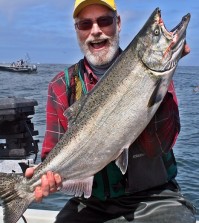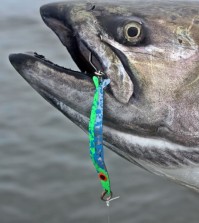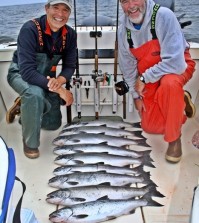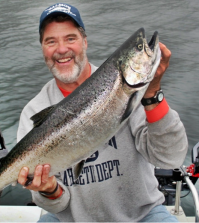Don’t Waste Time on the Water

If you’re not ready to fish when kings like these go on the bite, you’ll regret it for a long time! (Terry Rudnick photo)
The one little fatherly pearl of fishing wisdom that I most remember from my childhood days went something like: “You aren’t going to catch anything unless your line’s in the water.” Even at a young age I’d already figured that out, so I usually ignored Dad whenever he said it. I mean, duh, everybody knows that, right?
Only as I aged did I realize the real meaning of Dad’s first rule of fishing; wasted time on the water often leads to fewer fish in the box.
Most of us have been there, maybe dozens of times. As we cut the big motor and glide to a stop, we stand up to survey the surroundings for a moment before starting to fish, and suddenly realize that people in a couple of nearby boats already are playing salmon! You look around a little more carefully and discover that there are fish being played on several boats, so you claw into your rod locker like a mad man and grab your favorite rod. Only then do you remember that yesterday’s last fish was a slashing, gnashing, gnawing dogfish that ate your hooks and rolled up so badly in your main line that you had to cut it back five feet above the sinker. You look around once more and see that now virtually everyone within sight is playing a fish; everyone, that is, except you.
It could be a long, fishless morning.
Or, maybe not. If you’re at least a little bit organized, know a few shortcuts and time-saving little tricks, there just might be time to re-rig, get a line in the water and stick a hook into something worthwhile before the bite comes to an abrupt end.
Even if you aren’t in a hurry to get in on a hot bite, your chances of hooking salmon are almost always better when you’re actually fishing than when you’re rummaging around the boat looking for what you need or sitting there with the rod across your lap trying to get everything attached where it belongs. If the time you spend between limp line flying in the breeze and fully rigged and fishing can be cut from your usual 15 minutes to only four or five minutes, you’ll almost certainly catch more salmon between now and the time you back into that big boat ramp in the sky. All it takes is a little planning, a little practice and knowing a few of the shortcuts that trim precious time from the routine of getting your line back in the water.
Here are a few time-savers that should get you fishing a little quicker and cussing a little less:
START THE DAY WITH YOUR ROD RIGGED AND READY
It sounds simple and rudimentary but successful anglers are ready to fish when they hit the water. It’s surprising how many people start rigging their rod after they get to the first fishing spot of the morning. Since salmon, especially chinook, are often early morning biters, it doesn’t make sense to waste the first 10 or 15 minutes of daylight getting ready to start fishing. Have your favorite rod rigged and in a rod holder or leaning in a corner of the boat when you reach the fishing grounds, so all you have to do is add a fresh herring or snap the line into the downrigger release and you’re fishing. If you want to be doubly sure, have a second rod rigged and ready, too, just in case. Store it out of the way, but near enough that you can grab it in a hurry.
KEEP THINGS ORGANIZED

Whether they’re in tackle boxes, boat drawers, gear bags or shoe boxes, if you keep everything from hooks and swivels to spare downrigger balls and reel parts where you can find them and reach them quickly, you’ll spend less time searching and more time fishing. And when you finish with something, put it back where it belongs the second you’re done with it. Oh, yes, be sure to store related items together as much as possible. If you keep your jigs with your downrigger wire and your flashers with your spare spools of line, you’ll spend needless time fumbling through your equipment to find what you want. If all your trolling tackle is in one box, your mooching gear in another, and your jigs and jigging accessories in a third, you only have to open one box to find what you need for most any given situation.
USE SNAPS INSTEAD OF KNOTS
You can change out sinkers, attractors and lures very quickly if you pre-tie a little snap to the end of your main line and to your leaders. Not only will you save valuable time making gear changes on the water, you’ll probably have better, stronger knots in your system because you pre-tied them to your snaps in the comfort of your home or garage when you weren’t in a hurry. It’s also a good idea to keep those snaps closed when they aren’t actually in the water. Like hooks, open snaps have a habit of catching anything that gets near them, including nearby lines, leaders and rod guides, and sometimes you’ll have a heck of a time working them free from whatever they’ve grabbed. One morning at Westport a year or two ago, my fishing buddies got a two-salmon jump on me first thing in the morning as I sprawled out in the bow of the boat, trying desperately to get an open snap at the end of a line untangled from the bag of my back-up landing net. If you were anywhere within a quarter-mile of my boat that morning, you probably heard me swearing.
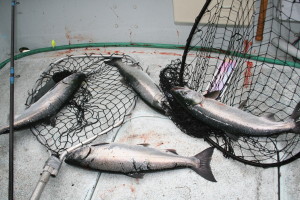
Be prepared and organized, and you may find ‘em coming in four at a time. (Terry Rudnick photo)
PRE-TIE YOUR LEADERS
This one should be a no-brainer, but I see lots of people out on the water tying their mooching leaders as they need them or rigging their hoochies from scratch, one at a time as they change from one lure to another. That can cost lots of fishing time. Not only should leaders be pre-tied whenever possible, they should be stored in a way that keeps them separate from each other and easy to access. Foam leader wheels are pretty much the standard these days, but some types of leader wallets and other systems may be best for you.
HAVE YOUR CHANGEOVER GEAR READY
If you decide to replace the spoon or hoochie that isn’t working or switch from flasher-and-fly to dodger-and-herring, have the replacement gear rigged, ready and laid out before retrieving your line. If you reel in the old rig and then start tying up the new one, you’ll spend maybe 10 minutes or more without a line in the water. If you really want to save time, tie the second rig on a backup rod, so all you have to do is reel one line in, set that rod down, pick up the second rod and start fishing again.
CARRY YOUR TOOLS ON YOUR PERSON
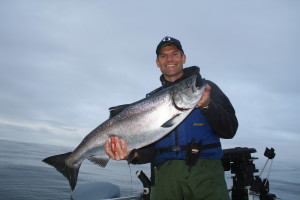
Be prepared and organized, and you may find ‘em coming in four at a time. (Terry Rudnick photo)
Whether you spend most of your time trolling, mooching or jigging, there are certain tools you use several times a day that can be easily misplaced. I’m talking about things like line clippers, pliers, hook files and—if you’re getting up in years like me—reading glasses for knot-tying and other close-up work. If you keep these tools on lanyards around your neck, in a shirt pocket or on your belt, they’re always handy when you need them, and that can save a lot of time during the course of a hectic day. Their small size makes them easy to misplace and hard to spot if you set them down after every use.
KEEP THE NET READY, BUT OUT OF THE WAY
Your landing net should always be extended and within reach, but not lying on the floor where you can trip over it or leaning against the inside of the gunwale waiting to snag your hooks—or, worse yet, with hooks already snagged in it. We’ve all wasted time trying to untangle nets from hooks, lines, sinkers, clothing and body parts when we should have been using them to net fish.



